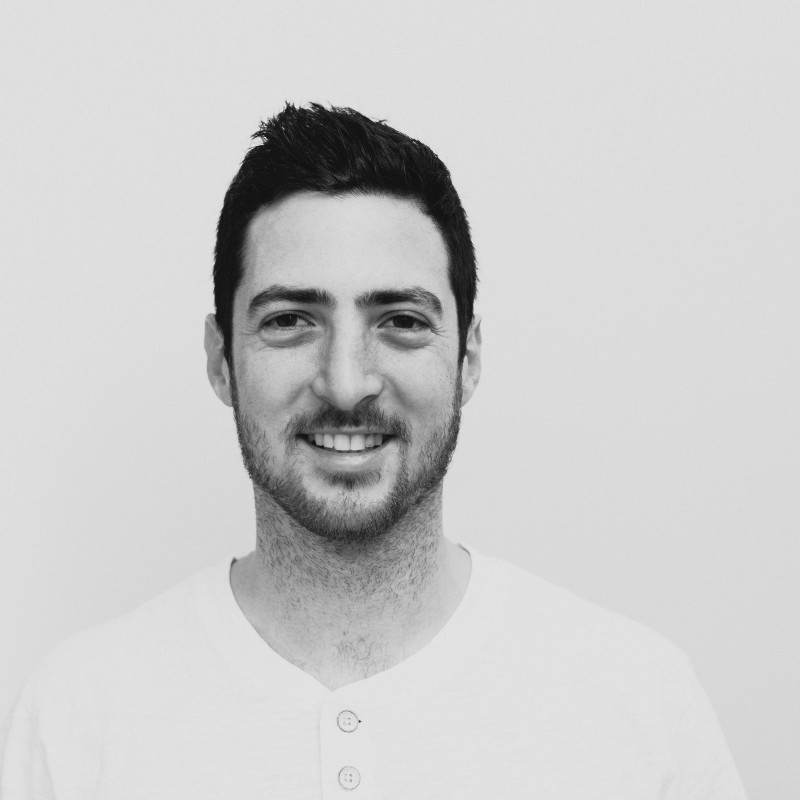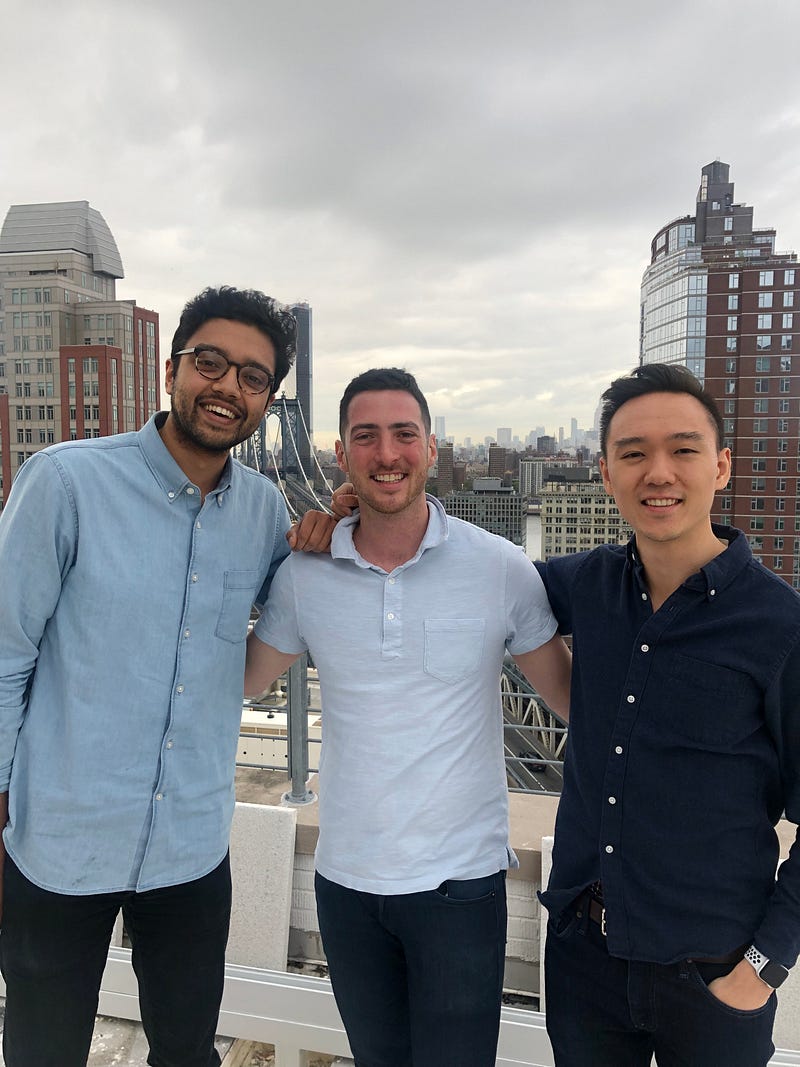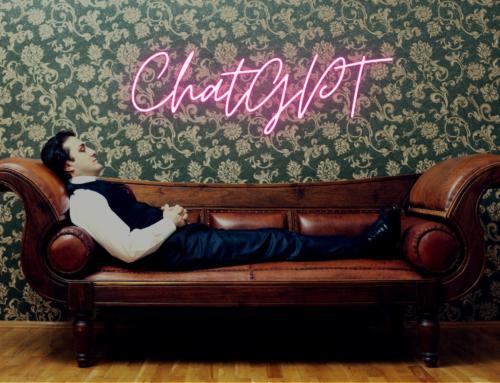I co-founded my first startup with two of my closest friends from college. We were all engineers studying computer science at Cornell.
After staying for grad school, we went our separate ways. A few years later, we rejoined each other (and added two more co-founders) in Boston to start an adventure that has become a lifelong passion — Entrepreneurship.
Starting a venture from scratch takes guts, it takes a vision, and it takes trust. Our team had all of this and more, and we just knew we would succeed. “I just don’t see how we can fail,” said one of my co-founders after an investor presentation in New York. That was nearly twenty years ago, and he was right. Within two years of our founding, we were acquired by a leader in our space. That drive and singular purpose are what I look for in founders.
On my first day as a New York Angel, I witnessed an investor pitch from three young entrepreneurs who reminded me of my co-founders. These guys exemplified the drive, grit, and wide-eyed passion that is required to succeed in your first venture.
I decided to write my first check that day because I wanted to see these guys succeed.
And that they did!
(I decided to also serve as an advisor and coach to the team. It is one of the most gratifying things I have done in a long time.)
This article is about those three bright young technologists — from diverse backgrounds and each bringing something to the table — that set out in 2016 to make a dent in the world of health, wellness, and beauty.
Their company Bowtie was acquired by MindBody this year.
(If you’ve booked a yoga, meditation, stylist, or gym class online lately, chances are you’ve used the MindBody platform and Bowtie.)
We caught up with Ron Fisher, the co-founder and CEO, fresh off their acquisition to record the journey while it’s still fresh in his mind.
(My colleague Cybele Ramirez interviewed Ron.)

Photo: Ron Fisher
CR: Hey Ron! So let’s start with the introduction?
RF: … I’m the co-founder and CEO of Bowtie. Bowtie is an artificially intelligent receptionist giving business owners freedom and peace of mind by ensuring they never miss a customer. We were recently acquired by MindBody, which has about 65,000 beauty, wellness, and health businesses on its platform.
CR: What’s Bowtie’s founding story?
Ron: My co-founders and I met while we were at school. Essentially what happened is that we wanted to create a predictive assistant for consumers. We realized that chatbots or AI messaging was going to be this powerful force for businesses. So, we ended up going in that direction. This was before Facebook opened itself up to the chatbots and the whole wave or trend started. We wanted to use AI to help small businesses specifically because we felt like there were so many companies going after enterprise customer service solutions, especially with AI, so we felt that was a saturated market. And so we decided to focus on, you know, what is actually 99% of businesses in America, small businesses, and create some sort of customer service solution.
CR: How did you and your co-founders eventually decide on what roles you would take on in the company?
Ron: It was relatively straightforward for us, because I was the business side of it so that kind of lent itself naturally to me being CEO. It was myself, Mike [Wang], and Vivek [Sudarsan]. Each of us had a pretty clear area of responsibility. Mike was focused on the back end and the AI, so he was the CTO. Vivek had a really strong design skill, is a coder, and was generally more in charge of the product so he ended up taking on the title of CPO. But, in terms of responsibilities, we all understood from the beginning what each person was bringing to the table.

CR: What do you look for in a team?
Ron: [At Bowtie], I think it is really important that people do wear many hats. For me it’s always like, okay, are you focused? Do you have your blinders on, just kind of doing what you know you need to do? Or are you going to do whatever it takes, whatever needs to be done? I think having the attitude of knowing no work is beneath you is important. The other thing we looked for when hiring is that they actually cared, they had a passion for what we were doing. That’s especially important in a startup. I think in a big company it’s more about your confidence in the role but for startup, it is pretty essential that they actually want to work here.
CR: What made you want to be an entrepreneur versus join a more established company after college?
Ron: I think I always knew I wanted to do a startup. Actually, I had a few attempted startups that didn’t go well but I still felt like I could do it. I think that most people hide their past or whatever but I definitely had things that started off projects and went nowhere. But I knew that I had to keep going. So when I was in school, it was the perfect avenue for it because I got to work with a strong team. I would say I always knew I wanted to be my own boss and create something that was new in the world, so that was my main drive in terms of wanting to do all of this.
CR: Can you speak more to being acquired by MindBody what you learned from the sale of your first venture?
Ron: Basically the way it happened was that we were originally in food. We pivoted into beauty because we felt like there’s a much better market opportunity. I think that was, in its own way, a lesson of needing to focus on solving problems that are meaningful enough that people will pay. So that led us to MindBody’s API, because we felt chatbots would be beneficial for beauty, wellness and health owners. Once we were MindBody’s API and figured out what we were doing, we grew on top of their platform. So we were demonstrating that their customers are willing to pay more for something else that sits on top of their own software. It made us an attractive acquisition because of the fact that people were paying, sometimes more, for our software than MindBody’s software, even though we were on top of it — you couldn’t use Bowtie without MindBody.
Then we started going to their conferences. So, what happened was we launched at their conference, because they found us in their API and we didn’t even have self-service onboarding yet. We paid a lot of money to do a booth at the conference because we had talked to many people and decided it was a really good idea to get the exposure, whether or not we felt we were ready. We launched self-service that day, on that morning. Vivek had worked on self service the entire night before, I found him sleeping with the computer on him. We went to MindBody’s conference and had a public launch. By doing that, we got all of this attention and spoke to so many customers. I had this amazing experience and made a really good impression on people there.
The following year, we went to the conference again.That year it was very interesting because they highlighted us as one of their six marquee partners on the main stage — we had no idea that was going to happen — alongside ClassPass, Google, there was Bowtie. I was like, oh wow, they really take it seriously.They had featured us on their earnings call so we knew that we were definitely on their radar. But, we thought that they were going to buy a competitor through a rumor we heard. So, we went to the conference to find out what was going on. When we were there we found out they weren’t in fact buying the competitor. Then while we were at lunch, Mike, the other co-founder and CTO, bonded with somebody who was on MindBody, who had been acquired. They really got along and that set off a series of conversations where that person went to the person in charge of M&A and told them that if they wanted to acquire Bowtie, now would be the time to do it. As a result of us actually showing up in person, and having previously made those good impressions at other conferences, that led them to reach out to us after the conference was over and say that they wanted to buy it.

CR: Did you have any coaches or mentors to guide you through the startup and the acquisition processes?
Ron: Oh, yeah. John Belizaire was definitely one of our number one advisors, mentors, and actually later on, investors.
He was essential in a few different ways. So one is he taught us how to focus. What that means is that we are all aligned on this mission, right, we singularly align the mission and we don’t deviate to anything that could take us away from that mission. He introduced us to this book called Radical Focus, which lays out the whole OKR system. It’s all about having objectives and key results, which really reoriented the way that our team worked. It was like we didn’t even understand how we were working before, it was very ad hoc. Having that framework for making decisions was huge. Celebrating each other’s wins at the end of the week — which is a key part of what the book instilled into us — that meeting every week where everybody gets together and says what they got done was a huge motivator. The second thing that he was essential in was teaching us how to sell and what the material needs to be to make that sale. So for the first sales deck we really sat down with him and showed him what we were thinking and he basically redrew it from scratch so we laid out the problems that the customer has then at the end walk through the solution and explain exactly how the benefits of the solution align with the problems. That whole outline that he laid out then ended up really forming the backbone of our sales deck, which ended up leading to something like our first 150 sales.
Another of our big advisors was my father, who is a VC. He was our advisor during the negotiation. He was stressing this whole thing, how one plus one makes three. The point is you’re not just giving them the thing and walking away. You’re actually creating a partnership together and you have to keep that in mind and keep reminding them of that throughout the process to at least get them to make the deal and to create a good context for the relationship when you’re an employee there.
CR: Looking back, is there anything about starting the business or the acquisition process you’d do differently?
Ron: Yeah, absolutely. This is something that John goes into a lot which is being customer obsessed or, you know, listening to your customer, constantly talking to your customer. I think we definitely started to do that once we pivoted. Before we pivoted into beauty, wellness and health, we didn’t talk to customers enough and that, I think, was our number one mistake. People think their next amazing business idea is going to be in their head, when you’re sitting in your room by yourself with a journal, totally detached from what you’re working on. But the reality is the best ideas are out there already, if you’re talking to the right people. That idea is going to come out whether it’s from your mouth or theirs. It’s actually for you to discover in those conversations, and the more of those you have, the more likely you are to create a really meaningful business. It doesn’t even need to come from your own problems, right, and that’s a huge thing for us. We knew nothing about beauty, wellness and health going into it. I mean, our three founders has never had more than a $30 haircut. So we ended up building a really compelling solution for beauty, wellness and health owners, thanks to constantly listening to them, and not just deciding things between the three of us.

CR: Now that that’s all said and done, what are your aspirations or what are you looking forward to?
Ron: I’m actually looking forward to how this scales. I mean obviously it would have been very nice to do this on our own, in some senses, but having this company starting to sell this product in mass having hundreds of people selling this is something that is really exciting to me and actually seeing thousands of businesses using this is something that I think is pretty incredible. Then, having a little more free time, I guess.
CR: What books helped you along the way?
Ron: Yeah so funny enough I started a ritual at the company, a monthly book club. At the end of the month, which ended up being six weeks, we all would get together in the morning an hour earlier and have breakfast and discuss what we learned. And so, probably 90% of those books were from John. It started with Radical Focus, which is, you know, our Bible. Who: The A Method for Hiring was really awesome and helpful for who to hire and when. Crossing the Chasm, which again I know is extremely popular, was really helpful especially in deciding who to sell to because it talks about self referential customer bases and if you’re selling to someone and the next person doesn’t trust the first person’s testimonial, then you don’t have a cohesive customer base. That was really important. A personal one that I thought was very good was How I Raised Myself from Failure to Success in Selling. It’s from the 50’s, about a very regular guy who ended up becoming a huge salesman. Learning about his journey was very impactful.
CR: Having built a company, having been a CEO, what’s one important play you’d like to share with new CEOs?
Ron: Yeah! I have two. One is don’t be afraid of pricing conversations, which is something that can be very intimidating at first. You can’t be afraid to get in there. There’s a formula out there, which says, “how much would you be willing to pay? What’s a lot? What’s beyond the max, like what’s too much?” I was definitely afraid to ask those questions in the beginning. I think that’s a really important because it gauges before your building if it’s worth anyone’s time, if they’re going to pay for it. The second thing is that when you’re starting a business in anything make sure you talk to at least 50 to 100 people in that industry, especially the ones you’re designing for. Interview a person and then at the end of the interview be like, hey do you have two people that you think would be good for me to talk to? Then, ask the next person for two more people to talk to that you think would be relevant. Suddenly you’re talking to all right people. Don’t be afraid to reach out to the ones that you don’t even know.
CR: What does being CEO mean to you?
Ron: CEO means inspiration. It’s really about inspiring people to care about what you are doing as a team, motivating them, and being willing to, again, fill in any gaps needed — without your own ego getting in the way.

More to the story
This story is a reminder of how life likes to come full circle.
My co-founders and I met at Cornell.
As a first-time-CEO, I reached out to the Cornell alumni network to get advice and coaching.
One of my favorite pieces of advice came from a serial entrepreneur. He was one of those alumni in Boston. He said, “if you forget everything I said to you, remember this… To succeed, you must be laser-focused!”
The message was to succeed; you must be laser-focused. An unwavering focus is a skill that you must master as a CEO. The market, your employees, your investors, even your loved ones, will pull you in different directions.
He was right.
20+ years later, I was on a sabbatical after the acquisition of my second successful startup. I reached out to the dean of Cornell Tech — a new gleaming graduate school campus in New York City that marries technology and entrepreneurship. The dean was my undergraduate advisor at Cornell’s engineering school. He was advising me again on how to connect to the local venture community. One of the first two VCs I met was 645 Ventures (645) and Newark Venture Partners (NVP). The co-founder of 645 was helping to run Cornell Tech’s spinout program. The general partner of NVP was also a New York Angel and sponsored me to join the group.
Ron, Mike, and Vivek met at Cornell Tech.
After founding Bowtie, they reached out to 645 and NVP about being connected with successful entrepreneurs.
“Hi John, below is one of the startup companies that recently spun out of Cornell Tech. The founder specifically asked to be connected to people who have B2B SaaS expertise. Would you be open to connecting with this founder?” said one of the intro emails.
I explained that I just saw these entrepreneurs at a NY Angels meeting and was very impressed.
When I met Ron and his team for the first time at their incubator offices at the New York Times building, my first piece of advice was: be laser-focused.
It’s timeless advice.


